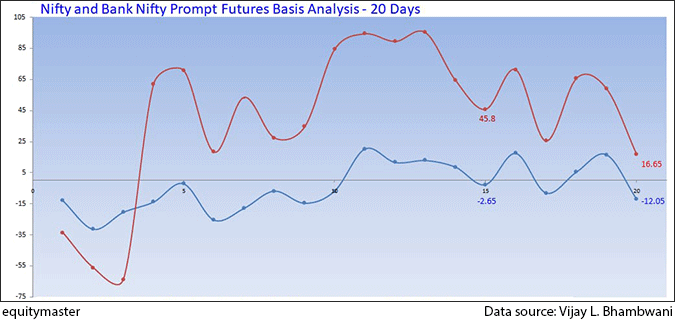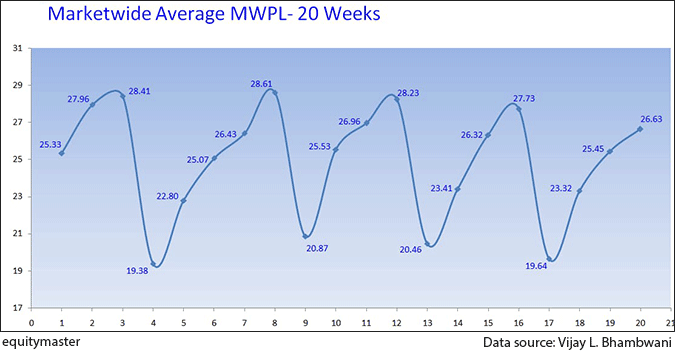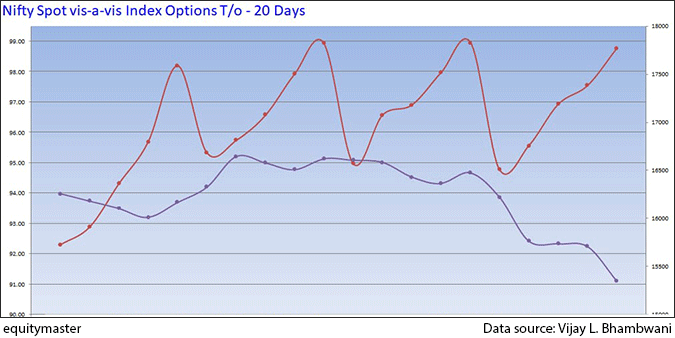What the Interest Rate Hike Means for Traders

The US Fed has raised interest rates. How does this effect you as a trader?
In this video, I tell you the implications of rising interest rates on your portfolio and on your open trades.
I'll also share my view on how you should be trading going forward.
Watch the video and let me know your thoughts. I love to hear from you.
Hello friends. The US Federal Reserve has raised its interest rates by 75 basis points, or three quarters of a percent. It now joins the ranks of India and, of course, the British central bank has also raised interest rates. And in this video, I want to talk to you about the implications, the fallout, of rising interest rates on your portfolios, on your open trades, and how you should be trading going forward.
First of all, I have been advocating that interest rates will rise, and that will push up being cost of funds. That has implications for the markets on the whole, because easy and cheap money is mother's milk to a bull market, and that era of easy and cheap money is ending. Somebody's turning off the tap.
Don't Miss: Best Chance to Access Midcap Stocks Research at 80% OFF
So markets are likely to fall lower because money that was required to speculate, to push prices higher and higher, is going to become difficult to get.
Why interest rates will rise across the board? This is something that I have explained to you in an earlier video. It's called the cash carry trade.
Here is country A offering 5% interest. Here is country B offering 10% interest. Money will go out of country A because it's giving only 5% and it will flow into country B it's getting 10%.
So if the Americans are raising interest rates, it will push the British, it will push the other countries, ultimately Germany, France, etc, in a domino effect, will have to push rates higher because money will flow out of their countries into America.
Now this cash carry trade compulsion will start a chain reaction, which is why interest rates are unlikely to stop rising any time soon. So it's a given that cost of funds are going to go up and there will be pressure on the markets.
Now a discerning trader is somebody who tries to find out whether the market is rising to rise further or rising only to fall or in case of a decline in the market, is the market falling so that it can stop and start rising at a future date or it is falling so that it can fall even more at a future date.
Now, since we are in a falling phase, we are going to discuss whether the fall is the beginning of a bigger fall, for it is just a corrective fall in the overall bull market.
Recently, I recorded a video about whether we are in a bear market or not. It's there in the playlist a couple of days ago. Feel free to review it again.
I've given you certain statistical evidence as to why I feel that we are already in a bear market, even though the classic Dow theory's pre-requisite that the markets fall 20% from their peak before you can call them a bear market has not yet been fulfilled. That will happen when the Nifty falls below the level of 14,800.
Do remember that the Dow theory is more than a century old when derivatives did not prevail. They were not there at all. Now add the cost of carry from the peak of October 2021 into the cost of a buyer who rolls over his long positions from October to June, and you will see that the 20% decline has already come in.
So a discerning trader must change with the times. You can be dogmatic. The book says so. Hey, the book was written over a century ago. So you want to live in pre-historic times, you're going to become a dinosaur.
Now, in another video a couple of months ago, I had said the first stocks that will get negatively impacted by rising rates are those companies for whom money is a raw material. Think about NBFCs. Think about banks.
The banks have to borrow money from the public on fixed deposit and offer interest rates. As you are already aware, in public domain, all banks have started offering higher and higher interest rates.
NBFCs, non-banking financial companies, borrow money from banks so that they can lend to the public or do business with it. Now banks' own interest rates are going up. So they are marking up interest rates to NBFCs even higher. This is why your HDFC and Bajaj Finance and Bajaj Finserv, and LIC Housing, etcetera, are slowly but surely falling lower.
The other kind of companies that will get negatively impacted are those who are import dependent for their raw material and/or finished goods but they are selling these goods in the domestic market. They are not re-exporting them.
For example, I'll simplify this for you. India imports a lot of raw diamonds, works on it, makes it cut and polished diamonds, and re-exports it. Now this business is unlikely to be impacted too much.
But imagine if you were to import something. The dollar is up and therefore you're landed cost is up and you have to sell it in the domestic market. There will be a fall in sales because prices have gone up. Now these companies, which are important dependent and selling their finished products in the domestic market, their stocks will be negatively impacted, which means they will fall.
The other companies that are going to get negatively impacted are those that are nursing a lot of foreign exchange loans. The one lesson that I learned from trading the financial markets through the Southeast Asian currency crisis of 1997-1998 wars, companies and countries that have a lot of foreign exchange debt, and their local currencies fall against the creditor nation, they tend to go bankrupt.
So those companies, which are nursing a lot of dollar denominated debt, will find paying interest and/or repaying the entire loan a little more difficult because it takes more rupees to buy a dollar today to repay that loan or even to pay interest on it. So those stocks will be negatively impacted again.
What is the difference for options traders? Now, this is something that I'm frankly, pretty worried about.
One of the factors that determines option premium is the risk free return rate. Call it the 10 year benchmark bond yield or a bank fixed deposit or a prime lending rate. Take it whatever you want. Bond rates are up. So your options premia is likely to see a bump up.
Also, understand that there is higher volatility in the market, which means higher IVs, implied volatility, so options premia might rise.
If you're an options buyer, stick with me till the end of the video, there is a special segment on options. If you're an options buyer, you might find you're paying a higher premium. Either to buy puts or in some cases, even the call premiums have gone up. That's surprising because call premiums should have fallen, but this is the interest rates that's talking.
Unfortunately, options are decaying or a wasting asset, which means with every passing day, the premium erodes just because time to expiry is shorter. So that decay will remain the same. But your premium has expanded, which means the risk reward is not in your favour anymore because the risk free rate will have gone up.
So please be very careful. Don't go overboard and wait till the last bit of this video before taking a call on options.
What about futures traders? They are also facing a very serious challenge, and it's a very unique situation. It's not something that you see every day.
You see, I work on statistical models, and what we are seen is fascinating, fascinating from the mathematical point of view. The guys who are at the receiving end, who are taking the mark to market losses, are not fascinated at all. Believe me when I tell you.

Now, with the risk free rate, the options and the futures premium should also go up because the cost of carry should go up. Unfortunately, at least in the case of the Nifty, it's trading between the positive and negative premium. A lot of times the index is witnessing a discount to spot.
That's worrying me. Why doesn't worry me? Because there are actually sellers even at a discount. Now that there's you that when traders are willing to sell at a discount, they are extremely bearish on the market. So probably markets are falling only to follow further rather than to rise in a hurry.
Now, the last bit and the very interesting bit here. You see this chart on your screen tells you what has been happening when the nifty has been sliding.

I told you in my video, whether we are in a bear market on not, which I recorded and uploaded last week, I gave you the MWPL data. MWPL is market wide position limits. This is the extent of exposure traders have taken as compared to what SEBI allows them. So market wide position limits after peaking out on a 16 November 2021 at 35%, have been falling. Now we are unable to cross even 30%.
So risk appetite has definitely gone down in futures. But our traders stopping their bullish efforts? Are they are giving up hope? They are not.

The chart on your screen tells you that they are now unable to afford futures because of mark to market losses, and therefore they are latching onto hope and buying options. This is worrying me. Why? Because options are relatively cheaper to buy, but then, losses calculated on futures are easier. Remember, there are just three series of futures available at any given point in time.
Calculating public losses on options is a whole not more difficult because, at least for the indices, there are weekly and monthly options. Then you have three series of options, and you have multiple strike prices.
So how much a retail investor actually lost on those misguided options trades you just don't know. And therefore, I feel that people, once they are desperate, they can't afford to go into futures, are latching on to hope and getting into options, and they are getting the life beaten out of them.
This is normally a very critical stage before capitulation. Capitulation is surrender. I can't hold on to my long positions any move. I can't bear the pain of losses. I can't pay mark to market and margin calls anymore, and therefore I give up. That is capitulation.
So we are a few steps closer to capitulation because traders have latched onto hope and gone from futures to options.
In my humble opinion, the sum and substance of this video is, are we falling to rise in a hurry, or are we falling so that we can fall further? I am tilted towards the latter argument. We are falling to fall further.
Can there be bear market rallies or technical corrections in between? Of course. Should get suckered into buying and thinking that it's the end of the bear market? That's your call. Alpha into Omega or Omega into Alpha. That's a call every trader takes for himself.
I'm inclined to believe that we are in for a decline, even from the present levels. So let's be careful out there because forewarned is forearmed.
On this optimistic note, I bid goodbye to you not before reminding you to click like on this video if you liked what you saw. Subscribe to my YouTube channel if you haven't already done so. Click on the bell icon to receive instant alerts about fresh videos being put up out here.
Good, bad, or ugly, I welcome your comments in the comments section and please help me reach out to fellow smart, like-minded traders like yourself by referring my video to your family and friends.
Thank you for your patience and being with me in my video. Till we meet again in my next, this is Vijay Bhambwani signing off for now.
Have a very profitable week ahead. Thank you.
Warm regards,

Vijay L Bhambwani
Editor, Fast Profits Daily
Equitymaster Agora Research Private Limited (Research Analyst)
Recent Articles
- Pyramiding PSU Bank Stocks September 22, 2023
- How to trade PSU banking stocks now.
- 5 Smallcap Stocks to Add to Your Watchlist Right Now September 12, 2023
- These smallcaps are looking good on the charts. Track them closely.
- Vodafone Idea - Can Idea Change Your Life? September 6, 2023
- What is the right way to trade Vodafone Idea?
- Repro Books Ltd: The Next Multibagger Penny Stock? August 28, 2023
- Is this the next big multibagger penny stock? Find out...


Equitymaster requests your view! Post a comment on "What the Interest Rate Hike Means for Traders". Click here!
Comments are moderated by Equitymaster, in accordance with the Terms of Use, and may not appear
on this article until they have been reviewed and deemed appropriate for posting.
In the meantime, you may want to share this article with your friends!